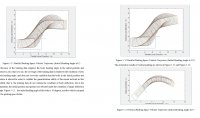基于MATLAB的自动泊车控制算法与仿真研究(英文版)

基于MATLAB的自动泊车控制算法与仿真研究(英文版)(任务书,开题报告,文献摘要,外文翻译,论文说明书英文版21000字,CAD图纸6张,MATLAB文件,答辩PPT)
Research on Automatic Parking Control Algorithm and Simulation Based on MATLAB(含MATLAB)(任务书,开题报告,文献摘要,外文翻译,论文说明书英文版21000字,CAD图纸6张,MATLAB文件,答辩PPT)
Abstract
With the increase of car ownership and the complex and crowded parking environment, it is difficult for drivers to complete the parking operation quickly and accurately, and even cause traffic accidents such as vehicle collision and road jam because of poor parking skills.The emergence of automatic parking system can help drivers parking safely and reduce the occurrence of safety accidents.
In this paper, the automatic parking process of an internal combustion locomotive with front wheel steering in parallel, vertical and skew parking spaces is studied by using MATLAB software, and the simulation is carried out. Firstly, according to vehicle parameters and obstacle avoidance constraints, the minimum parking space and parking starting position are calculated. Meanwhile, the path planning of parallel parking spaces is carried out by quintic polynomial, and the path planning of vertical parking spaces and skew parking spaces is carried out by quadric polynomial. Finally, fuzzy control algorithm and neural network algorithm are used to realize automatic parking. [来源:http://Doc163.com]
Finally, the pre-operation, decision-making speed, correlation coefficient between input data and output data of the two algorithms are compared. Both algorithms need a lot of preliminary work. Fuzzy control needs to establish a fuzzy rule base, while neural network needs a lot of data training, so that the two control algorithms can complete automatic parking. The decision-making speed of the neural network algorithm is faster than that of the fuzzy control algorithm, and the correlation coefficient is larger. At the same time, the generalization ability of the neural network algorithm is better, and the requirement of the initial position and posture of the vehicle is lower.
Key words:Automatic Parking; Control Algorithm; MATLAB/Simulink; Fuzzy Control; Neural Network
[来源:http://Doc163.com]




Contents
Abstract Ι
[版权所有:http://DOC163.com]
Chapter 1 Introduction 1
1.1 The Background and Significance of Research 1
1.2 Research Status and Analysis of Automatic Parking System 1
1.2.1 Current Research Situation Abroad 2
1.2.2 Current Research Situation in China 3
1.2.3 Analysis of Automatic Parking System 6
1.3 Research Status of Parking Space Detection 7
1.4 The Main Research Contents of This Paper 8
Chapter 2 Calculation of Parking Parameters and Starting Position 9
2.1 Establishment of Vehicle Kinematics Model 9
2.2 Parking Parameters Determination 11
2.2.1 Calculation of Minimum Turning Radius in Reversing Process 12
2.2.2 Minimum parking space required for parallel parking 13
2.3 Calculation of Starting Point Area in Parallel Parking Space 14
[版权所有:http://DOC163.com]
2.4 Calculation of Starting Point Area in Vertical Parking Space 17
2.5 Calculation of Starting Point Area in Skew Parking 20
2.6 Summary 22
Chapter 3 Path Planning of Automatic Parking System 24
3.1Parallel Parking 24
3.1.1 Parallel Parking Path Planning 25
3.1.2 Simulation of Parallel Parking Path 26
3.2 Vertical Parking 29
3.2.1 Vertical Parking Path Planning 29
3.2.2Parking Path Simulation of Vertical Parking Space 30
3.3 Skew Parking 33
3.3.1 Parking Path Planning for Skew Parking 33
3.3.2 Parking Path Simulation of Skew Parking 36
3.4 Summary 38
Chapter 4 Design and Simulation of Fuzzy Control Algorithms 39
4.1 Basic Principles of Fuzzy Control Algorithms 39
4.2 Design of Fuzzy Controller 41
4.3 Path Tracking Simulation 46
4.4 Summary 63
Chapter 5 Design of Neural Network Control Algorithms 64
5.1 Basic Principles of Neural Networks 64
5.1.1 Working Principle and Structure of Neurons 64
5.1.2 Working Principle and Structure of Neural Network 65
5.2 Establishment of Neural Network Model 67
5.2.1 Data Acquisition of Neural Network Training 67
5.2.3 Establishment of Hidden Layer Model of Neural Network 70
5.2.3 Selection of Neural Network Training Algorithms 72
5.2.4 Establishment of an Automatic Parking Model Based on Neural Network 73
5.3 Summary 78
Chapter 6 Comparing and Evaluating Algorithms 79
6.1 Preliminary Work Contents of Two Algorithms 79
6.1.1 Preliminary Work Content of Fuzzy Control 79
6.1.2 Preliminary Work Contents of Neural Networks 80
6.1.3 Comparison 81
6.2 Decision Speed of Two Algorithms 81
6.3 Relevance Coefficient of Simulation Results of Two Algorithms 81
6.4 Summary 82
Chapter 7 Summary and Prospect 83
References 85
